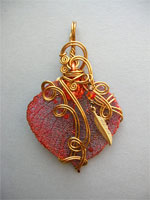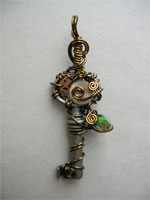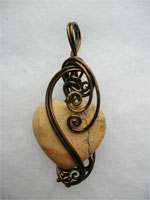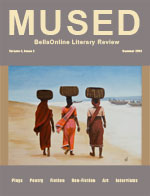Kendra Tornheim
Lisa Shea
An artist often precariously balances between following her own vision of life’s beauty and finding an audience who believes in her style enough to support her progress. If an artist tunes her activities just right she is able to spend her time immersed in a fantastical world, brimming with joy, while being showered with kudos from a grateful fan base who loves the creations she brings to life. Such is the world of Kendra Tornheim, an artist who works in the realm of wire work jewelry.
Kendra’s love affair with crafting began when she was quite young. “My mother is a fiber artist, primarily a felt maker, and so as a child I learned to card wool and to spin. I also helped her out at various craft shows, so how craft shows work was familiar to me before I ever displayed my own work at one.”
“I was lucky that my high school had a good 3D art program with a teacher who specialized in ceramics and glass but taught other sculpture and metal techniques as well. I took a class with him every year and got to try out copper foil stained glass, enameling, plaster and wood carving, wire sculpture, clay pot making, and papier-mache. My school system also had a summer camp program where I took jewelry and calligraphy classes as well as musical theatre.” This experience demonstrates how important school art classes can be to aspiring artists!
Kendra’s imagination found kindred spirits in the Society for Creative Anachronism (SCA). “A friend of mine in the SCA taught me basic lucet braiding during the Pennsic War. I loved that here was something to do with my hands that I could take with me, the way my mother would take her knitting. I took my lucet and thread with me nearly everywhere. The following Pennsic I learned how to weave beads into the lucet braid. From long lengths of beaded lucet cord I moved into calculating the length of cord and placement of beads necessary to make choker necklaces. That Christmas, while visiting my boyfriend's parents, his mother watched me making lucet chokers and said she would love to have one. I gave one to her as a gift, and when she said to me, ‘You know, you could absolutely sell these!’, I think that was the first time I had considered selling jewelry to the public.”

A library is a free, fantastic resource for crafters. “A few months later it occurred to me that I could probably learn one of the techniques that had always interested me, off-loom beadweaving, from books from the library. I found a wonderful book on beaded amulet bags that covered a variety of stitches, and I began to practice beadweaving and to read every book and magazine I could get my hands on.”
As with many artists, the role of a supportive circle was critical to Kendra’s growth. “I have several other friends who create jewelry of various types, and one of them saw a notice for a craft show that fall to benefit the metro-west humane society. Three of us decided to chip in for a booth together, so that no one was risking too much money if we didn't sell anything. That gave me a deadline to make sure I had some inventory ready to sell. Slightly before that show, I started playing with wire, and wire quickly became my primary fixation. ”
“That first show meant that I had inventory ready to go, and didn't go so badly that I wanted to reject the whole idea. So after that I had reason to look for more venues. I applied to my first juried show, Celebrate Newton, and shared a booth with my mother. I learned about Etsy from a friend and started a shop there.”
Kendra’s style involves gorgeous wire swirl designs which are intricate and spellbinding. “For most of my life, I have tended to produce swirling, art nouveau-esque semi-stylized shapes. When I was younger, I did a lot of doodling and drawing, and you can see these types of forms there.”

“I am personally drawn to forms that are a combination of stylized and organic. My greatest influence in wire, however, was undeniably Kythryne of Wyrding Studios. A friend had directed me to her website many years earlier, and I think I always had a sense that that was the type of wire work I wanted to do: where the wire moves in exactly the right curving directions, much like the drawings I made. I also love spirals, though, and almost all of my wirework features either tight or loose spiral shapes.”
There is a naturalistic allure to Kendrda’s works – a glistening green leaf, a delicate silver feather. “I think this is another part of the juxtaposition I love of stylized and organic forms. I find images like a ruined stone gateway in the woods, or a window half overgrown with ivy, to be incredibly appealing. There's a kind of magic in them, a sense of lost places and transformation. I also like the notions of technology becoming affected or animated by the natural. I think of my clockwork key pendants that have leaves on them as if a spirit of the natural world possessed the mechanical key so that it sprouted its own little leaves. I like the idea of such keys sprouting wings too, and flying off.”

The keys are a potent symbol which appear often in Kendra’s creations. “Like many people, I've always found keys and especially old barrel keys to be appealing. Like ruins and gateways, keys play into a sense of secret places, lost and hidden things that you might find. I was one of the kids who dreamed of having a secret room hidden behind the walls of the house that was my own special den. Because of that appreciation for keys (and also old things and antiques: my father is an antique collector and my whole family are historic house enthusiasts), I already had a few antique keys on hand when I started playing around with wire; I had picked them up at an antique shop I visited with my family. While I was experimenting with wire, wrapping a variety of objects, I first wrapped one of these keys. Decorating the shape of the old key, and adding in the little watch gears, was very satisfying. I found that the hardware store had inexpensive skeleton keys for sale, so I wrapped some of those, with more gears and little leaves, and then bought a batch of old keys from eBay. I found that people bought the key pendants through Etsy much more often than any of my other work, and that encouraged me to focus more on the keys.”
“A magical place should have a magical key to open it. In so many stories, that's the first hint, the first step, to entering a magical place: you find the key, or are given the key. So a particularly special key will make you think of the place it opens. I think of many of my key pendants that are overgrown with leaves and swirls of wire as keys to fae gardens or groves, entrances to magical lands. I think of the clockwork keys as keys to realms where the man-made melds with the fantastic, or as keys to start up and operate strange half-technological, half-magical machinery.”
Every artist knows how challenging it can be to transition from creating your dream objects for yourself to attempting to earn a living selling the items to an audience. Kendra muses, “It seems to me that that step has to do with figuring out how to present your jewelry to the public, and thinking of yourself as a craftsperson, not 'just a hobbyist' -- as someone who deserves to be paid for your work and your time.”
“A caveat, here: I'm barely earning income from my jewelry, myself. Last year I was able to cover the cost of my materials, show and transportations fees, and pay myself a little bit for my time, but the net amount I was able to pay myself for the entire year would barely cover one month's worth of life expenses. I'm someone who is not planning to quit my day job, which I think would be a much bigger step. I'm lucky to work at a job I like which can pay my bills, and which is flexible enough that I can also work on my jewelry business and my shows.”
“It seems to me that in making the transition to selling your work to the public, it's great to have some initial low-investment opportunities to experience selling to customers. For me, doing the non-juried craft show for a good cause, sharing a booth with friends, was wonderful. If you can find a local show that's for charity, or a church holiday fair, that can be a good early experience. Even if you don't sell much, you can feel good about helping a cause. And just seeing that people are willing to look at your work and, hopefully, buy some of it can give you a needed boost in confidence.”
“I also recommend starting an Etsy shop and putting up good photos of a handful of items -- but not being discouraged if you don't see sales for a while. I think having some work up on Etsy early is a great idea, because it takes time for your network of people who have 'hearted' your shop and items to grow. It acts as a gallery where people can see your work, and there's probably more of a chance that people will find you using Etsy's search mechanism that there is that they would find your own website. Getting marked as someone's favorite on Etsy, and especially making some sales, can also be a big boost to your confidence about marketing to the public.”
Kendra believes in being prepared for any opportunity. “Especially if you're doing a craft show, you'll want to have business cards that list a website or Etsy store where people can look at your work or some examples of it online. You can also wear your jewelry when you go out, and have business cards with you to give out to people who compliment you or express interest. For a while I just photocopied my own design onto cardstock and cut them out by hand, but the quality is much better if you use Vistaprint, which has very low-cost deals all the time. I've also gotten a lot of interest from people, and given out a lot of business cards, when I'm doing some sort of craft in a public place -- like on a bus.”
There are many options out there for an artist to examine – a personal website, in-person sales, a community site like Etsy. Kendra covers all bases. “I think it's good to do some of all of the above. I like having my own website because there are some things Etsy can't show: for example, any work I've done that didn't sell through Etsy. I use my own website as a gallery, but very rarely sell anything directly because of my site. I like Etsy because you can take advantage of Etsy's search engine and promotion; I feel that people are more likely to find your work through Etsy than by finding your independent web site (though of course that may depend on how actively and effectively you are promoting your web site). There are a lot of things you can do to make people more likely to find you on Etsy, and a lot of discussion and hints on the topic on the Etsy forums and articles. It's nice to have a trickle of regular sales even when you aren't doing shows.”
“I think it's important to do in-person sales too, though. Even with good photos, there's nothing quite like seeing a piece of jewelry in person, especially where you can try it on. I generally sell a lot more at one go at a craft show, renaissance faire or convention than in months on Etsy. I give out a lot of business cards at those places, too, and I'm sure many of those people find me later online, when otherwise they would never have found my Etsy shop or my website.”
Artists should customize their efforts based on what they are creating. “You also need to find out what venues work well for your style. I seem to do much better selling at science fiction conventions or renaissance faires than at craft galleries. The largest part of my work currently are the key pendants, and those are quirky -- very appealing to a certain set of people, but not so much of interest to the mainstream. Individual shows also vary a lot depending on the clientele. And of course, you need to take into account the fees for the venue, and how much your trip costs, to see if it's worth it for you.”

It can seem that our modern world bombards consumers with cookie-cutter jewelry in a plethora of mall based shops. Kendra believes a high quality artist will always find ways to thrive. “I think that if you have something new or different, some people will find it very appealing. At the same time, if you have something that is very reminiscent of what people are used to seeing, many people will find that appealing too. There was recent research I've read about that showed that when something seems familiar, people in general really do like it more. I think that probably means that it will work well not to be wildly different from what's out there, at least for some pieces, but to have some aspect that is distinctive.”
“If you are creating unique art jewelry, there are a lot of people who will not make good customers for you. It's probably not worthwhile trying to make your jewelry appealing to people who would rather either buy something inexpensive at the mall, or people who would like to buy something very expensive at the mall that looks like what everyone else wears. But there is also a substantial group of people who are interested in art jewelry and unique pieces, and will be happy to see (and buy) something new. You just need to find them, or help them find you.”
“There are a lot of venues, both online and in person. There are also massive numbers of jewelry artists trying to participate in and market themselves in those venues. I think it is challenging to market yourself, and you need to persist despite setbacks, rejections, and poor sales. If you put in effort and research, though, you can find venues that work for you and make sales happen.”
Kendra believes strongly in expanding your horizons and encouraging yourself to continually grow and learn. “One of the things I like about wire is that there are so many techniques to play with that I haven't even touched on yet, or have barely started to experiment with. The wire filigree pieces are a new direction for me, but they obviously use a lot of my familiar style and motifs. I intend to try out wire weaving basketry-type techniques, and see if I can work those in to both the filigree and the key pendants. I've never tried oxidizing my wire or my finished pieces, but I have the supplies and the instructions ready to go as soon as I have a chance. :-) Some day I'll get around to making rings, or more bracelets. I like that it doesn't seem likely to become boring any time soon.”
Be sure to visit Kendra Tornheim’s website at SilverOwlCreations.com, and her Etsy shop at SilverOwlCreations.Etsy.com!

